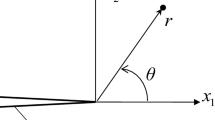Abstract
The interaction integral (I-integral) method is a numerical technique based on the theory of path-independent energy conservation integrals, efficiently and accurately yielding stress intensity factors (SIF) for crack loading analyses. The drawback of the method, however, is that the requirement of auxiliary fields, which are commonly taken from asymptotic crack tip solutions, impedes a straightforward application to curved crack paths unless the integration contour is contracted to the crack tip. Thus, in hitherto available literature, fracture mechanical analyses based on the I-integral have been restricted to straight cracks under mixed-mode loading. This paper presents consistent approaches for the calculation of the I-integral in homogeneous, plane structures with arbitrary curved cracks based on finite integration contours. Relations between both coordinates I k of the interaction integral and SIF are derived. If crack face integrals are necessary to maintain path independence, special numerical treatment is required. Results are presented and verified by comparing the loading quantities from the I-integral to values calculated by conventional methods.
Similar content being viewed by others
References
Barsoum R.: On the use of isoparametric finite elements in linear fracture mechanics. Int. J. Numer. Methods Eng. 10, 25–37 (1976)
Bergez D.: Determination of stress intensity factors by use of path-independent integrals. Mech. Res. Commun. 1, 179–180 (1974)
Budiansky B., Rice J.: Conservation laws and energy-release rates. J. Appl. Mech. 40, 201–203 (1973)
Cherepanov G.: Crack propagation in continuous media. J. Appl. Math. Mech. 31, 476–488 (1967)
Eshelby J.: The force on an elastic singularity. Philos. Trans. A 244, 87–112 (1951)
Eshelby J.: The elastic energy-momentum tensor. J. Elast. 5, 321–335 (1975)
Gosz M., Moran B.: An interaction energy integral method for computation of mixed-mode stress intensity factors along non-planar crack fronts in three dimensions. Eng. Fract. Mech. 66, 299–319 (2002)
Gosz M., Dolbow J., Moran B.: Domain integral formulation for stress intensity factor computation along curved three-dimensional interface cracks. Int. J. Solids Struct. 35, 1763–1783 (1998)
Gross D., Seelig T.: Fracture Mechanics. 2nd edn. Springer, Berlin (2011)
Henshell R., Shaw K.: Crack tip finite elements are unnecessary. Int. J. Numer. Methods Eng. 9, 495–507 (1975)
Herrmann A.G., Herrmann G.: On energy release rates for a plane crack. J. Appl. Mech. 48, 525–528 (1981)
Judt P., Ricoeur A.: Accurate loading analyses of curved cracks under mixed-mode conditions applying the J-integral. Int. J. Fract. 182, 53–66 (2013)
Kim J., Paulino G.: The interaction integral for fracture of orthotropic functionally graded materials: evaluation of stress intensity factors. Int. J. Solids Struct. 40, 3967–4001 (2003)
Kuna M.: Finite Elements in Fracture Mechanics. Springer, Dordrecht (2013)
Moës N., Gravouil A., Belytschko T.: Non-planar 3d crack growth by the extended finite element and level sets—part i: mechanical model. Int. J. Numer. Methods Eng. 53, 2549–2568 (2002)
Moghaddam A., Ghajar R., Alfano M.: Finite element evaluation of stress intensity factors in curved non-planar cracks in fgms. Mech. Res. Commun. 38, 17–23 (2011)
Muskhelishvili N.: Some Basic Problems of the Mathematical Theory of Elasticity. Nordhoff International Publishing, Leyden (1977)
Rice J.: A path independent integral and the approximate analysis of strain concentration by notches and cracks. J. Appl. Mech. 35, 379–386 (1968)
Rouzegar S., Mirzaei M.: A comparative study on 2D crack modelling using the extended finite element method. Mechanika 19, 390–397 (2013)
Rybicki E., Kanninen M.: A finite element calculation of stress intensity factors by a modified crack closure integral. Eng. Fract. Mech. 9, 931–938 (1977)
Stern M., Becker E., Dunham R.: A contour integral computation of mixed-mode stress intensity factors. Int. J. Fract. 12, 359–368 (1976)
Walters M., Paulino G., Dodds R.: Interaction integral procedures for 3-D curved cracks including surface tractions. Eng. Fract. Mech. 72, 1635–1663 (2005)
Wang S., Yau J., Corten H.: A mixed-mode crack analysis of rectilinear anisotropic solids using conservation laws of elasticity. Int. J. Fract. 16, 247–259 (1980)
Williams M.: On the stress distribution at the base of a stationary crack. J. Appl. Mech. 24, 109–114 (1957)
Yu H., Wu L., Guo L., Wu H., Du S.: An interaction integral method for 3D curved cracks in nonhomogeneous materials with complex interfaces. Int. J. Solids Struct. 47, 2178–2189 (2010)
Author information
Authors and Affiliations
Corresponding author
Rights and permissions
About this article
Cite this article
Judt, P.O., Ricoeur, A. Consistent application of path-independent interaction integrals to arbitrary curved crack faces. Arch Appl Mech 85, 13–27 (2015). https://doi.org/10.1007/s00419-014-0897-z
Received:
Accepted:
Published:
Issue Date:
DOI: https://doi.org/10.1007/s00419-014-0897-z




